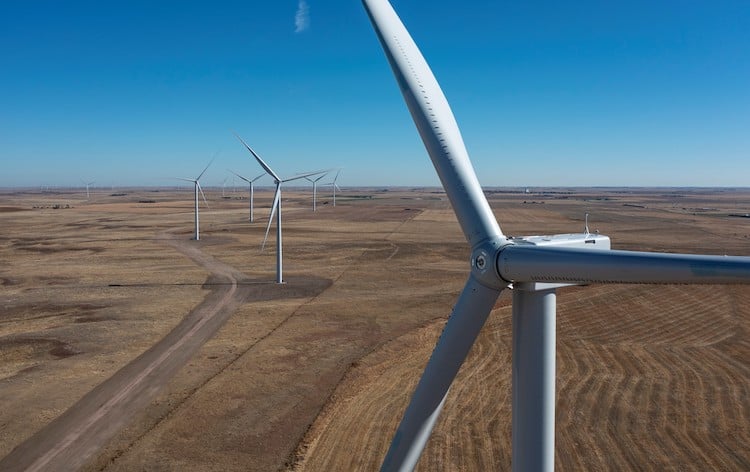New wind penetration record of 64% achieved in May
by Allen Best
A new wind farm in northeastern Colorado has made a county treasury a little richer, the income of landowners a little more secure, and the electricity distributed by Tri-State Generation and Transmission a little cleaner.
The 200-megawatt Niyol Wind Energy Center was celebrated on Nov. 4 with a ribbon-cutting that included Logan County Commissioner Jane Bauder and Colorado Lt. Gov. Dianne Primavera as well as representatives of the utility company and the wind developer.
In the next 30 years, the wind farm will generate $25 million in payments to owners of the underlying land about four miles from Fleming, a town of 400 people amid the wheat-farming and cattle-grazing country east of Sterling. One third of the wind farm is on trust land governed by the Colorado State Land Board, with revenues earmarked for schools.
NextEra Energy Resources, the owner of the wind farm, will sell the power generation to Tri-State, Colorado’s second-largest electrical utility, in a power-purchase agreement. NextEra projects that the 74 wind turbines and other infrastructure will generate $24 million in property taxes for Logan County and other taxing districts.
The world’s largest generator of renewable energy from wind and the sun, NextEra has become a major figure on the Colorado energy landscape in the last decade. It has 10 of what are now called “energy centers,” with about 2,000 megawatts of generating capacity. They range from a small solar project between Boulder and Niwot, to major wind farms on the eastern plains. Two solar-storage projects under construction.
Tri-State had clung to coal generation for far too long in the eyes of critics, including many member cooperatives, but has begun to pivot significantly toward renewables. Duane Highley, the chief executive, called the commissioning of the wind farm near Fleming “another significant step in our energy transformation.”
The utility supplies electricity to 42 member cooperatives and public power providers, 18 of them in Colorado and the remainder in Nebraska, Wyoming, and New Mexico.
It now has six large, utility-scale wind and three solar projects in place. Two of these have come on since Tri-State announced in January 2020 its plans to completely exit coal generation in Colorado – although not in Wyoming and Arizona – by 2030, to be largely replaced by renewable generation. The first wind farm to come on line after that was Crossing Trails, near Siebert Colo., with 104 megawatts of generating capacity.
In 2024, Tri-State expects to have more than 800 megawatts of solar, 670 megawatts of wind and 600 megawatts of large and small hydropower generating capacity. That’s more than 2,000 megawatts of emission-free resources on Tri-State’s 3,000-megawatt system.
The resource plan submitted to the Colorado Public Utilities Commission also calls for an additional 2,000 megawatts of renewables and storage resources by 2030.
On May 20, Tri-State set a peak when renewables altogether served 64% of demand from Tri-State’s members.
Why support Big Pivots?
You need and value solid climate change reporting, and also the energy & water transitions in Colorado. Because you know that strong research underlies solid journalism, and research times take.
Plus, you want to help small media, and Big Pivots is a 501(c)3 non-profit.
Big grants would be great, but they’re rare for small media. To survive, Big Pivots needs your support. Think about how big pivots occur. They start at the grassroots. That’s why you should support Big Pivots. Because Big Pivots has influence in Colorado, and Colorado matters in the national conversation.
- How much water remains in the aquifers of southeast Colorado? - April 18, 2024
- Keeping water rights on the Yampa while utilities figure out future technologies - April 18, 2024
- How can Colorado add this much renewable energy by 2040? - April 18, 2024





